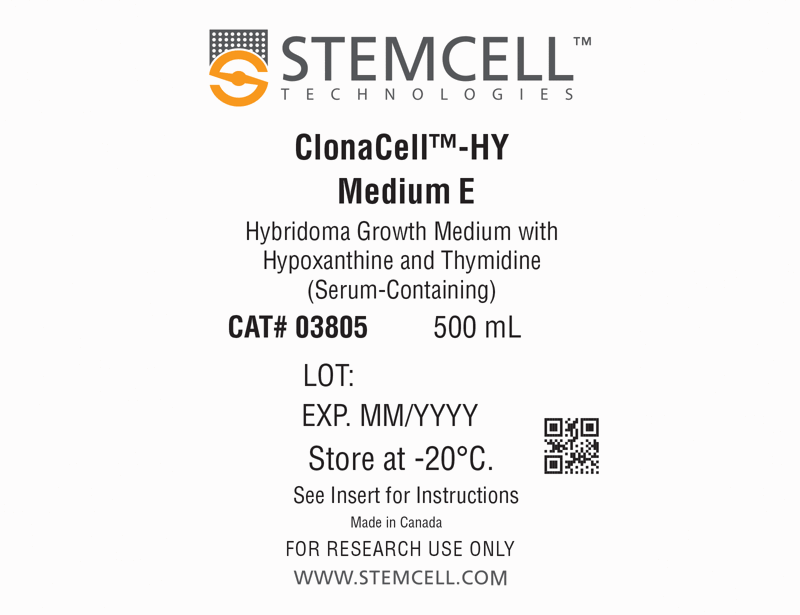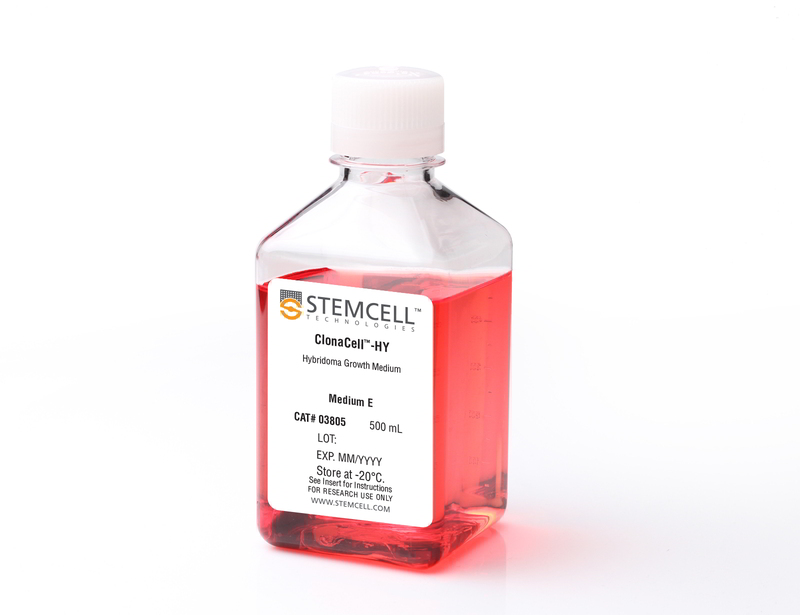ClonaCell™-HY Medium E
Hybridoma growth medium with hypoxanthine and thymidine (serum-containing)
概要
ClonaCell™-HY Medium E is a serum-containing, nutritionally rich liquid medium optimized for hybridoma expansion after hypoxanthine, aminopterin, thymidine (HAT) selection. The medium contains hypoxanthine and thymidine (HT) and is used to wean hybridomas off aminopterin used during the selection process. This medium has been verified for use in mouse and rat hybridoma development and monoclonal antibody production and reportedly is compatible for production, cloning, and expansion of hybridomas using lymphocytes from a variety of host animals including human, mouse, rat, and hamster. ClonaCell™-HY Medium E has proven effective for subcloning and stabilization of unstable hybridoma cell lines.
Contains
• DMEM
• Serum
• Hypoxanthine and thymidine (HT)
• Gentamicin
• 2-Mercaptoethanol
• Phenol red
• L-Glutamine and other supplements
• Other ingredients
• Serum
• Hypoxanthine and thymidine (HT)
• Gentamicin
• 2-Mercaptoethanol
• Phenol red
• L-Glutamine and other supplements
• Other ingredients
Subtype
Specialized Media
Cell Type
Hybridomas
Species
Mouse
Application
Cell Culture, Hybridoma Generation
Brand
ClonaCell
Area of Interest
Antibody Development, Cell Line Development, Drug Discovery and Toxicity Testing, Hybridoma Generation
技术资料
| Document Type | 产品名称 | Catalog # | Lot # | 语言 |
|---|---|---|---|---|
| Product Information Sheet | ClonaCell™-HY Medium E | 03805 | All | English |
| Special Protocol | ClonaCell™-HY Medium E | 03805 | All | English |
| Manual | ClonaCell™-HY Medium E | 03805 | All | English |
| Safety Data Sheet | ClonaCell™-HY Medium E | 03805 | All | English |
数据及文献
Publications (2)
Cell 2019 may
A Site of Vulnerability on the Influenza Virus Hemagglutinin Head Domain Trimer Interface.
Abstract
Abstract
Here, we describe the discovery of a naturally occurring human antibody (Ab), FluA-20, that recognizes a new site of vulnerability on the hemagglutinin (HA) head domain and reacts with most influenza A viruses. Structural characterization of FluA-20 with H1 and H3 head domains revealed a novel epitope in the HA trimer interface, suggesting previously unrecognized dynamic features of the trimeric HA protein. The critical HA residues recognized by FluA-20 remain conserved across most subtypes of influenza A viruses, which explains the Ab's extraordinary breadth. The Ab rapidly disrupted the integrity of HA protein trimers, inhibited cell-to-cell spread of virus in culture, and protected mice against challenge with viruses of H1N1, H3N2, H5N1, or H7N9 subtypes when used as prophylaxis or therapy. The FluA-20 Ab has uncovered an exceedingly conserved protective determinant in the influenza HA head domain trimer interface that is an unexpected new target for anti-influenza therapeutics and vaccines.
Virology 2011 jul
Subcellular location and topology of severe acute respiratory syndrome coronavirus envelope protein.
Abstract
Abstract
Severe acute respiratory syndrome (SARS) coronavirus (CoV) envelope (E) protein is a transmembrane protein. Several subcellular locations and topological conformations of E protein have been proposed. To identify the correct ones, polyclonal and monoclonal antibodies specific for the amino or the carboxy terminus of E protein, respectively, were generated. E protein was mainly found in the endoplasmic reticulum-Golgi intermediate compartment (ERGIC) of cells transfected with a plasmid encoding E protein or infected with SARS-CoV. No evidence of E protein presence in the plasma membrane was found by using immunofluorescence, immunoelectron microscopy and cell surface protein labeling. In addition, measurement of plasma membrane voltage gated ion channel activity by whole-cell patch clamp suggested that E protein was not present in the plasma membrane. A topological conformation in which SARS-CoV E protein amino terminus is oriented towards the lumen of intracellular membranes and carboxy terminus faces cell cytoplasm is proposed.


